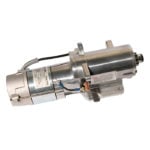How does an aircraft starter work?
The process of starting an aircraft engine isn’t exactly the same as starting your car in the morning. The average aircraft engine needs a boost to get going, and luckily, a device called a starter provides exactly that. There are many mechanical components that make up an aircraft starter, and each plays an important role in the process of starting an engine. We’ll explain everything you need to know about the device, what it does and how it works.
The parts of an aircraft starter
The following are some of the most important parts of an aircraft starter, which help it run properly to complete its job:
Battery — powers the starter
Flywheel — a heavy metal disc on the flange of the engine crankshaft
Magnetos — self-contained, high-voltage generators used in modern general aviation starters
Spark plugs — used to ignite fuel and air mixture inside the cylinders
Starter adapter — a “clutch-like” device used as part of the starter system on many aircraft engines, which connects the starter motor and engine
How it works
Now that you know all the components involved, let’s get to the important part. Here’s a step-by-step breakdown of how the aircraft starter works:
- A small gear attached to the starter unit is responsible for engaging the flywheel, which kick-starts the whole process.
- The flywheel turns the crankshaft, which forces the pistons to move up and down.
- The magnetos start spinning, which generates a strong current that travels to the spark plugs.
- When the spark plugs ignite a mixture of fuel and air in the cylinders, the engine starts and your aircraft is ready to go.
More about magnet starters
Modern aircraft starters use permanent magnets that are lighter-weight and more powerful than the direct-current electric motors of traditional starters. These permanent magnets are used in place of heavy field windings to generate a current. Typically, aircraft starters will have a left and right magneto — that is, a self-contained, high-voltage generator — which spin inside a coil to create a magnetic force and ultimately, ignite the spark plug.
What is an aircraft starter adapter?
Many Continental engines use aircraft starter adapters to provide that extra “push” needed to get the engine fired. The starter motor is mounted to the adapter at a 90-degree angle. When the motor starts spinning, it turns a shaft inside the starter adapter, and a larger brass gear starts to spin as a result. As the rotational speed increases, a coil spring attached to that gear tightens and turns the drive shaft and starts the engine. When the speed of the engine exceeds that of the starter, the spring tension is released and the starter turns off.
The problem of overheating aircraft starters
It’s not always easy to get an aircraft engine started, and this can be the source of much frustration. However, in the process, it’s important to keep in mind the risk of your starter overheating.
Tip: if your first attempt at starting the engine fails, you may want to consult your Pilot Operating Handbook (POH) to determine how long to wait between attempts. This allows your starter to cool before trying again.
